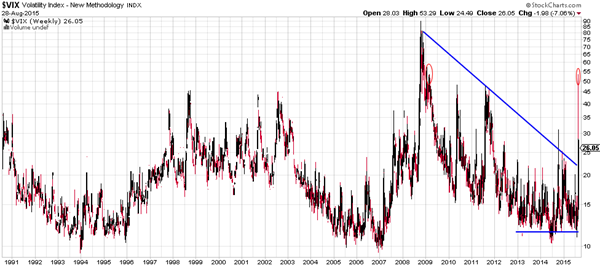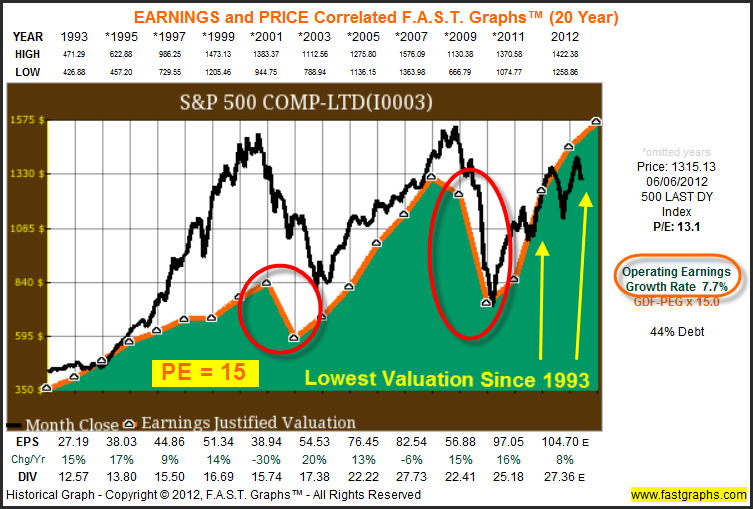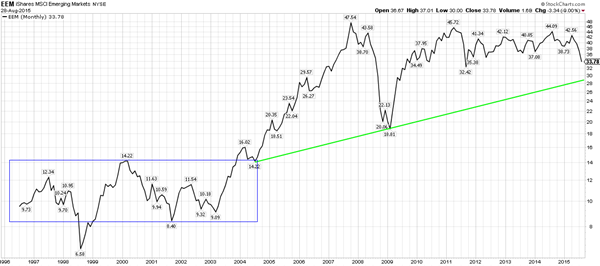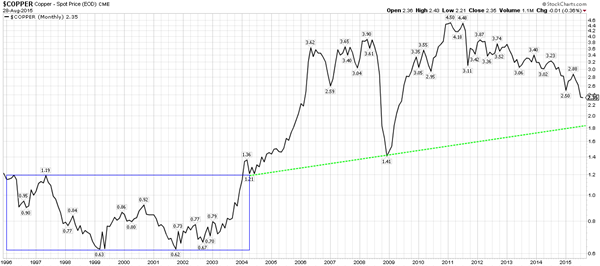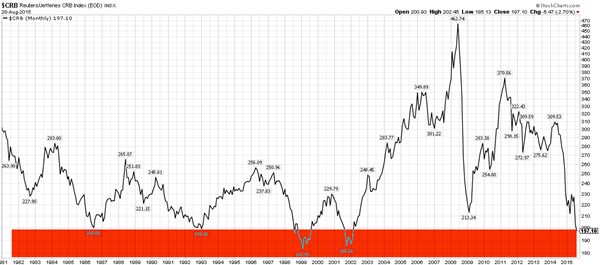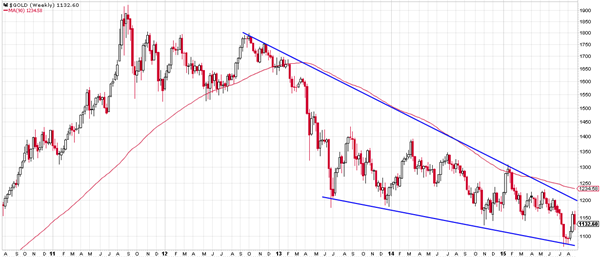Personal Finance
The markets were ‘shockingly’ interesting last week. But what investing opportunities have been created by the recent ‘shock’?
The seriousness of last week’s shocking action in the market is shown by the volatility index, which posted its second highest reading since its inception in 1990. This is comparable to the great crash of 2008/9.
Ed Note: Charts like the one above are linked. Supposedly to a larger chart. Until corrected, the links present the chart in the same size.
There has been much discussion regarding technicals and charts. Instead, we prefer to focus on the trend, particularly the uptrend since 2012, without analysing the myriad of technical indicators. The weekly chart of the S&P 500 shows the uptrend is still intact (green dotted line below), although the S&P 500 arrived at a critical ‘make-or-break’ point. The weekly close on the trendline, only a couple of points above the 100 week moving average, suggests that all scenarios are still open.
However, the bad news for stock investors is that the 2009 uptrend is violated on the monthly chart, the most relevant chart type for secular trends. August is setting up for the first monthly close below the 2009 trendline. The odds now favor a continued decline, unless proven otherwise. Structural support comes in at the 2007 top, at 1600 points for the S&P 500, which is 19% below today’s levels.
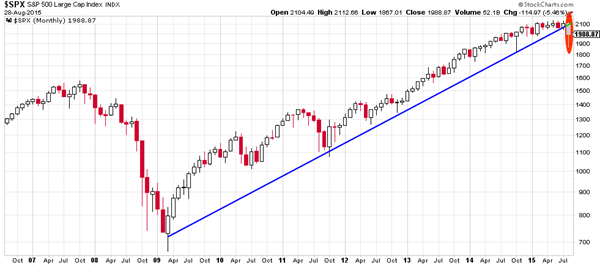
Our preferred indicator for the stock market is its correlation with the Federal Reserve balance sheet. Since 2009 it has been a very reliable indicator, as shown by the chart below. Uncoincidentally, the Fed’s balance sheet stabilized in late 2014, when the process of ‘Tapering’ was completed. Since then, the stock market has traded sideways following the Fed’s balance sheet.
That correlation suggests a weak future for stocks, unless the Fed intervenes with monetary stimulus, which was not what the Fed hinted during their recent announcements. Based on the Fed’s balance sheet and monetary decisions, one can assess whether U.S. stocks will offer opportunities or whether a cautious stance is preferable.
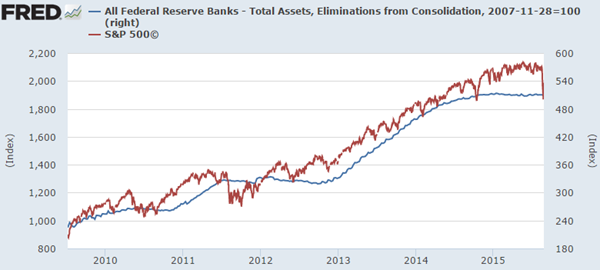
Global stock markets have fallen much more than in the U.S. In particular emerging markets are now down 39% since it peaked in June, triggered by the crash of the Shanghai stock exchange. How much more downside is likely? Based on the trend started in 2004, after a long consolidation period, we think the downside is another 10 to 15%. Knowing that this year’s correction in the emerging market index is already 22%, this could be an interesting space for opportunities in the coming months.
The correction in emerging markets is also reflected in copper’s spot price. As a leading indicator, Dr. Copper lost 18% of its value from its 2015 top until today. It is no coincidence that the secular trend on copper’s chart is similar to that of the emerging markets; even the percentage decline is comparable. Based on the secular trendline, the downside in copper is another 19% before it hits major support. We view this as a confirmation of the emerging markets forecast discussed above.
That brings our focus to commodities in general. Driven by the collapse of key commodities oil and copper, the damage in the commodity space has been huge. Since the 2011 top, the CRB index, a proxy for the commodity complex, has lost 45% of its value. Year-on-year, the index is 37% lower.
The good news for commodities is that they are hitting a secular bottom, as indicated by the red bar on the chart above. The 4 decade low is only 7% below today’s level. This seems like another area where opportunities will arise in the coming months.
What about gold? Is an opportunity developing? The most interesting trend on the longer term gold chart is the deceleration of gold’s decline. Although the trend remains down, with a clear formation of lower lows, the decline is slowing. Also note that the lows have occurred in an orderly manner, not comparable to the aggressive declines of April and June of 2013. This indicates selling pressure is fading and that gold is bottoming. The gold mining industry has been slaughtered, so the miners that survive this deep crisis will outperform once the tide turns in precious metals. Although a trend change takes time, we believe that opportunities are manifesting in gold, silver and miners.
Note on gold’s chart that the wedge is now ripe to change its trend. The quality of the wedge is high, with at least 3 tests at each side of the pattern. We wouldn’t be surprised at all if gold would start a secular breakout later this year. Mark our words!
We have purposely left currencies out of our analysis. Given the degree of central bank currency interventions, we believe the risk is too high for secular investors.
The conclusion regarding the markets is that the heavily sold emerging markets and some commodities will likely continue their decline, but they are setting up a major bottom in the not-too-distant future, potentially after more capitulation. Stocks in the U.S. are sitting at major support, so current price levels must be watched closely, as well as the monetary policy of the U.S. Fed, given the strong correlation between the Fed’s balance sheet and U.S. stock indices. Although gold is still declining, it is signaling an exhaustion of its decline and potentially an breakout from its downtrend.

Summary
- Currency weakness is being driven by GDP issues, which are not tied to the health of the Canadian economy as directly as we think.
- Economic weakness stems from weak commodity prices, an improvement of which would drive the economy well past where it is today.
- Concerns about over-leveraged Canadian consumers and high price of Real Estate underestimate the ability of Canada’s Financial System to compensate.
- The main investment vehicles within Canada are being dumped along with energy and materials, despite the remaining companies’ value and lack of exposure to those assets.
- There are opportunities in Canada for those who are bullish and bearish on commodities, and the housing and debt factors are less influential to the thesis than many believe.
As a commercial banker, I have seen the issues I hear so many pundits speak about, and I have my own opinions about the very curious case of Canada.

Breadth, Profitability, China, and Greece All Add Up
The S&P 500 has lost critical technical support at the 200-day moving average and the 2,000 level — putting its post-2011 uptrend in jeopardy. Many observers pooh-poohed the importance of the technical “death cross” last week. Turns out to have been meaningful indeed, as it was a milepost by which to observe the stark loss of market momentum.
S&P 500 Weekly trading at 1935 at 7:04am PST August 26th
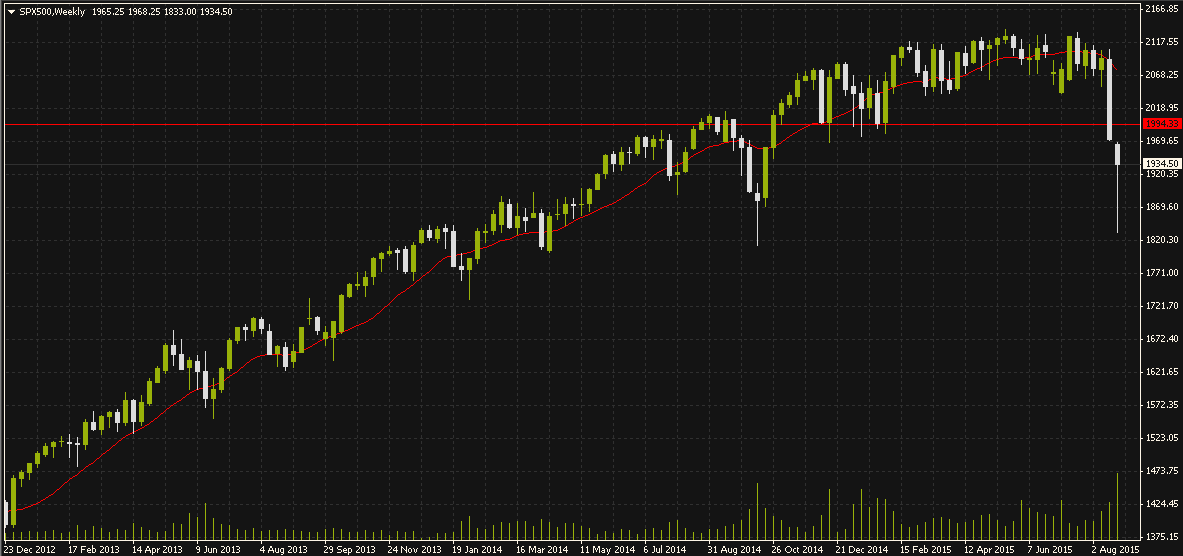
Globally, the Shanghai Composite lost its 200-day moving average — a critical measure of the long-term trend — after authorities had vigorously defended the line in the sand since early July. Bourses from Japan to Germany are all wilting. Treasury bonds and precious metals have been on the rise as investors seek safe havens. And currencies of emerging market countries from Vietnam to Kazakhstan are under pressure.
The PowerShares U.S. Dollar Bullish Fund (UUP) lost its 200-day average for the first time since last summer. The yen and the euro are rising, despite aggressive stimulus efforts by the Bank of Japan and the European Central Bank, as popular currency “carry trades” are slammed.
There may be no single driver for the decline, but a number of factors have combined in the context of what had been quiet calm in the U.S. stock market:
— There’s been a multi-month decline in market breadth, as fewer and fewer U.S. stocks participated to the upside. We have chronicled this.
— Corporate profitability has been pressured by slowdowns overseas, the stronger dollar, a tightening job market, and lower energy prices. We’ve also noted this.
— China has seen a marked slowdown in its economic data, has suffered a 32% stock market decline, and conducted a surprise devaluation of its currency last week.
— Greece is back in the news as Prime Minister Alexis Tsipras has stepped down ahead of snap elections.
— Tensions are rising on the Korean peninsula after North and South Korea exchanged artillery fire.
Besides China, the acceleration of last week’s decline seems to have been driven by concerns surrounding the approach of a potential Federal Reserve interest rate hike on Sept. 17.
We’re in the midst of “hike havoc” — not unlike the “taper tantrum” of early 2013 as former Fed Chairman Ben Bernanke considered the beginning of the end of the QE3 bond purchase stimulus program.
Will the Fed ignore building financial market turmoil or be pressured into waiting?
The Fed seems to be tilting toward an earlier rate liftoff with a pause afterwards (the “one and done” scenario for 2015). Yellen has tried, unsuccessfully, to play down the importance of liftoff timing and has said that wage growth and inflation aren’t a precondition for the initial rate hike.
St. Louis Fed President James Bullard, who famously saved the market back in October during the Ebola-driven selloff by reassuring investors that the Fed could unleash more stimulus if needed, also raised expectations of a September hike Friday when he said the Fed doesn’t react directly to equity markets and that he’s more optimistic about the global economic outlook than the market is.
For investors who have grown complacent in the belief the Fed will always support markets, this was like an ice pick through the heart on an already scary day.
The last time the Fed faced a cliffhanger decision, it blinked. Bernanke delivered a surprise “no taper” decision at the September 2013 policy meeting; postponing the taper until December, just three months before current Fed Chairman Janet Yellen began her term.
 Will Yellen fold, too? The drop in the dollar suggests currency traders believe she will.
Will Yellen fold, too? The drop in the dollar suggests currency traders believe she will.
Yet the selloff in pretty much everything else suggests a nagging fear the world’s most important central banker is about to turn hawkish, focusing on steady job gains and stable GDP growth while ignoring the market rout. According to Oxford Economics, the U.S. economy is growing at a 3% annual rate, which is not too shabby.
Capital Economics believes the Fed has set a “pretty low bar for a rate hike” and with GDP growth likely to be higher than the Fed’s June projection they not only “think that the Fed will raise rates in September, but there would appear to be a good chance of a second hike in December as well.”
Analysts at Nomura think differently, and see the odds of two rate hikes this year at only 8% and put the odds of a September hike at only 20%. Their most likely outcome is the first hike coming in December (with 44% odds) followed by no hike at all in 2015 (at 36% odds).
Much depends on the strength of the August jobs report on Sept. 4 — the last before Yellen & Co.’s fateful decision. Stay tuned.
Best wishes,
Jon Markman

 “Given a sufficient number of people and an adequate amount of time you can create insurmountable opposition to the most inconsequential idea.” ~ Anonymous
“Given a sufficient number of people and an adequate amount of time you can create insurmountable opposition to the most inconsequential idea.” ~ Anonymous
Contrarian investing is a dynamic field and not a static one. The assumption that it’s a static field is held by the new breed of fashion contrarians, whose only donation to this field has been to glamorize it and distort the correct notion of being a contrarian investor. These fashion contrarians are no different from those with the mass mindset; they only pretend to do things differently, but the moment fear or uncertainty is in the air, they flee for the exits like bandits being chased by the hounds of hell. A true contrarian in most cases understands the basic rules of mass psychology. If you are not familiar with these rules, you are doing yourself a disservice and should catch up on them ASAP.
At the Tactical Investor, while we embrace the concept of contrarian investing our true focus is on the joining the key rules of contrarian investing with the authoritative concept of mass psychology. We believe this combination creates one of the most robust trading systems out there; psychology is the key driving force behind almost every human action, so understanding should be one of the main goals of every investor.
We are going to provide a list of rules that we believe are the most important in terms of contrarian investing. It will provide both the novice and seasoned trader with ideas that should help improve your trading skills if implemented properly. Discipline and patience are the keys to successful investing; nothing comes easily, for if it did, everyone would be able to do it and then it would cease to be profitable, as the masses never win in the long run.
These contrarian guidelines by no means encompass all the rules associated with the concept of contrarian investing. However, they do provide you with a firm foundation on which to build your investment career.
1) Trendy media (magazines, news outlets, newspapers, TV stations, etc) should be treated in the same light as toilet paper; it has some use, but its function is to perform a distasteful action. Use these outlets to determine what the masses are frothing about and what you should avoid or start getting out off or into. Remember the emotions should be at boiling point. You do not oppose the masses just because they started to jump on the bandwagon; its only when the bandwagon is overloaded and about to buckle under the load its carrying that you should look for an exit and vice versa.
2) Technical analysis plays a key part when it comes to investing, regardless of whether you choose to be a contrarian investor or not. It is imperative that you take time to understand the basic tenets of this very important field. Do your best not to follow or focus only on the most popularly used Technical analysis indicators. You will be amazed at how effective some of the lesser known indicators are once you get to understand how they function and operate.
3) Spend time understanding the markets you are going to target or the sectors of the stock market you intend to play. We have put up an extensive list of resources, all of which are free here. Free Trading Resources
4) Formulate a sound plan. Don’t be an imbecile and sit there wishing and hoping to catch a home run. Those that adopt such notions, always catch a falling dagger, a process that is fraught with pain and misery. The plan should include profit targets on each and every trade, and, an exit plan, in case the trade does not work out.
5) Do not foolishly jump into Options until you grasp the key concepts of buying and selling stocks. In other words, understand when to buy and when to sell……… Make some money and then attempt your hand at options.
6) Learn to relax; if you don’t relax it’s really hard to win. Disease is a body not at ease, so if you are not at ease, you will most certainly perform dismally in the markets.
7) The law of balancing comes into play here. When you win a significant amount of money, help one person in your life time and your rewards will be 100 fold.
Other interesting points contrarian investors should adhere to
A real contrarian only jumps into the investment because the asset is trading at mouth-watering levels, and blood is flowing freely in the streets……….. Buy when the crowd is paralyzed with dread and panic and bail out when the crowd is buying hand over fist.
When you are excessively secure or feeling elated; fly for the exits.
Never get a hot head and think you know it all. Even the best can be taken out. Make sure you have stops in place; the markets are currently very volatile.
Contrarian investing is really about emotions. You are overcoming your emotions and playing/preying on the emotions (fear or greed) of the crowd by taking an opposing position.
When you take a position and people look at you with contempt or astonishment, you know you are doing the right thing…… When they pat you on the back or start giving you high five’s; the end is in sight and it’s time to flee for the exits… Buy low. Sell high.
“Everybody sets out to do something, and everybody does something, but no one does what he sets out to do.” ~ George Moore

 Habit #4 – Knowing the Market
Habit #4 – Knowing the Market
The more you engage with customers the clearer things become and the easier it is to determine what you should be doing.
John Russell
Successful business owners are exceptional problem solvers, especially when it comes to solving their customers’ problems. Over the years, I have seen many early stage and emerging companies fail as they “push” their offer into the market, while more seasoned company’s offers get “pulled” into the market. The difference is in the mindset of the leader, executive, entrepreneur or business owner who is responsible for the business. This attitude is not only limited to the world of tech startups, but many inexperienced business people can fall into the trap of believing they know what the customer wants better than the customer themselves! They are thinking of a solution, before solving the problem.
While the customer may not know the precise form of the solution and may not even be able to articulate the problem, they do
know it hurts and that they are willing to pay for a solution. For instance, prior to purchasing the fledging Seattle coffee shops that eventually became Starbucks, Howard Shultz famously toured hundreds of coffee shops in Italy and found that the secret to great coffee shops was not the great coffee, but great meeting places. His solution was to create a great place that sold coffee, and the rest, as they say, is history!
Here are the four things you can do to develop the habit of other successful business owners in knowing your market:
Serve a Segment: Avoid boiling the ocean and identify one segment of the market you not only plan to serve, but dominate! It can be segmented by demographics, industry vertical, income levels, consumer behavior or buying patterns. Whatever it is, be very specific about what segment you are serving, and understand that segment intimately.
Feel the Pain: Focus on what pain or problem the customer is experiencing. If it’s B2C, it’s likely about service convenience or cost. If it’s B2B, the pain is usually too much risk, not enough time or too much money. Find it, understand it, define it and solve it!
Above Average Growth: Successful business owners focus on markets that are growing, preferably above the average for the industry or the economy. This drives higher margins and greater opportunities to dominate, particularly during the early stages of new markets.
Sell Globally: Often said, but not always done. While it is a great strategy to start small and regional in order to prove out the concept, the business strategy must be focused on global markets, no matter what business you are in. In the information age, even a small regional player can build a global following. Think global and act global!
Developing the habit of becoming clear, concise and deeply knowledgeable of the market you are selling into will help you become a better business leader and accelerate the growth of your business.
Selling innovative, well-priced and good value offers into this market, particularly those growing fast and with a global presence, will increase the probability that you can ultimately dominate the sector, and create an unassailable competitive advantage.
Thinking like your customer and focusing on how you can solve meaningful problems for them is the fastest way to build a great company!
By Eamonn Percy
For all 10 Habits and other articles go HERE


